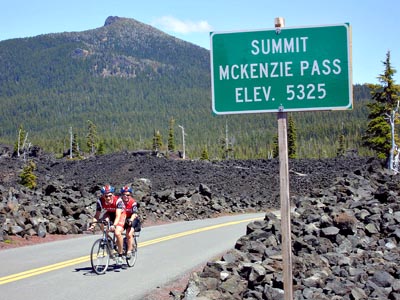For Oregon pioneer family, highway robbers were lifesavers
Two armed men who apparently came to rob travelers helped pull them over the pass instead after discovering there were six children in the wagon

Two cyclists make the summit at McKenzie Pass, on Highway 242, in
the summer of 2005. (Image: David Hunter)
By Finn J.D. John — February 6, 2010
Downloadable audio file (MP3)
There’s a reason McKenzie Pass — Highway 242 over the cascades, from Springfield to Sisters — is closed in wintertime. The pass can be a dangerous place after the snow starts to fly, which can happen any time after around Labor Day.
A century ago, though, the weather was only one of the dangers travelers on the pass faced. Highway robbers were another. These operators patrolled the pass looking for travelers who had gotten stranded by the sudden blizzards and frozen to death.
Sometimes, when they encountered travelers who hadn’t gotten around to dying yet, they helped the process along with their six-shooters. And then, of course, they helped themselves to the now-ownerless horses, along with whatever loot they could pack, before shoving the wagons off the roadbank and into the canyon below.

The Dee Wright Observatory, near the top of McKenzie Pass. The
observatory was built by the Civilian Conservation Corps during the
Great Depression, using the distinctive rock of the lava fields there.
(Image: UO Libraries)
This was exactly the treatment George Harvey Dyer expected to receive in the fall of 1897. And although it’s not clear why he didn’t, it’s at least a good possibility that he was saved by his six children.
Dyer was a Civil War veteran, a Southerner who had been forced to fight for the North after he was captured — or so the story goes. Whatever the real story was, his service in the Union army made him unpopular at home in Arkansas after the war, so he emigrated to Oregon and settled near Woodburn.
But in the late 1890s his wife died, leaving him with six children — three boys and three girls, none of them over 10 years old — and he found out about an opportunity for work in the town of Burns. Dyer packed the kids in his wagon and set out.

This postcard image of McKenzie Pass dates from the 1960s. Highway
242 has seen some upgrades since then -- although it still closes for the
season when winter comes.
He headed south to Springfield, taking advantage of the Willamette Valley’s relatively excellent roads, and took the McKenzie Pass route toward Bend and eventually Burns. This almost turned out to be a fatal mistake. It was late in the year — early autumn, in fact. And if you’ve ever been over the pass in the spring or the fall, you know how striking and sudden the change of climate is there. While people are still swimming in lakes and frolicking on beaches below, snow is piling up around the Dee Wright Observatory.
As Dyer got near the summit of the pass, his luck ran out. A blizzard settled in on him. Snow blew, drifted in the wagon road. His horses were floundering in it. The wagon was sliding behind them, dead weight, like a sled with no runners. It didn’t look as if they’d make it. This must have been a soul-crushing realization for Dyer, because he was within a stone's throw of the summit of the pass. If he could just make it to the summit, gravity would give the horses enough help to move the wagon down the other side ... but heave and thrash as they might, the big animals simply couldn't do it.
That’s when the highwaymen showed up. Three of them on horseback, bristling with weapons.
As Dyer’s great-grandson tells the story, the old man — pretending not to know what they were up to — looked them straight in the eye and asked for their help pulling the wagon over the pass. And, after a long and chilling silence, they tied their lariats to the wagon and helped drag it to the top.

NASA workers and an unknown astronaut conduct tests on a space
suit in 1968, in the lava beds near McKenzie Pass in Central Oregon.
(Image: OSU Archives)
Why would hardened criminals do that? Well, it seems likely that the prospect of murdering a wagon-load of toddlers and elementary-school-age children was more than they were willing to undertake. Or maybe they were just feeling unusually merciful that day. Who knows?
In any case, had it not been for the arrival of those three bandits, the entire Dyer family would have frozen to death a few yards short of the pass. Thanks to the robbers, they were able to make it to Burns, where Dyer was able to take advantage of the opportunity he’d heard about and go into business — as a casket builder.
(Sources: Dyer, Ed. “Dangerous Encounter,” Little-Known Tales from Oregon History. Bend: Sun Publishing (Cascades East Magazine), 1988.)
TAGS: #McKenziePass #HighwayRobbers #WagonRoad #SixChildren #Highway242 #GeorgeHarveyDyer #DeeWrightObservatory #CasketBuilder #EdDyer
-30-











